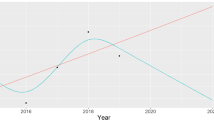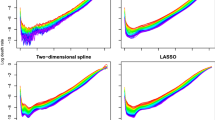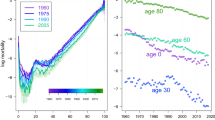Abstract
This paper proposes a spline mortality model for generating smooth projections of mortality improvement rates. In particular, we follow the two-dimensional cubic B-spline approach developed by Currie et al. (Stat Model 4(4):279–298, 2004), and adopt the Bayesian estimation and LASSO penalty to overcome the limitations of spline models in forecasting mortality rates. The resulting Bayesian spline model not only provides measures of stochastic and parameter uncertainties, but also allows external opinions on future mortality to be consistently incorporated. The mortality improvement rates projected by the proposed model are smoothly transitioned from the historical values with short-term trends shown in recent observations to the long-term terminal rates suggested by external opinions. Our technical work is complemented by numerical illustrations that use real mortality data and external rates to showcase the features of the proposed model.












Similar content being viewed by others
References
Billari FC, Graziani R, Melilli E (2012) Stochastic population forecasts based on conditional expert opinions. J R Stat Soc Ser A (Stat Soc) 175(2):491–511
Billari FC, Graziani R, Melilli E (2014) Stochastic population forecasting based on combinations of expert evaluations within the Bayesian paradigm. Demography 51(5):1933–1954
Cairns AJ, Blake D, Dowd K (2006) A two-factor model for stochastic mortality with parameter uncertainty: theory and calibration. J Risk Insur 73(4):687–718
Camarda CG (2019) Smooth constrained mortality forecasting. Demogr Res 41:1091–1130
Camarda CG et al (2012) Mortalitysmooth: an R package for smoothing Poisson counts with p-splines. J Stat Softw 50(1):1–24
Chang L, Shi Y (2020) Dynamic modelling and coherent forecasting of mortality rates: a time-varying coefficient spatial-temporal autoregressive approach. Scand Actuar J 2020(9):843–863
Currie ID (2013) Smoothing constrained generalized linear models with an application to the Lee–Carter model. Stat Model 13(1):69–93
Currie ID, Durban M, Eilers PH (2004) Smoothing and forecasting mortality rates. Stat Model 4(4):279–298
Currie ID, Durban M, Eilers PH (2006) Generalized linear array models with applications to multidimensional smoothing. J R Stat Soc Ser B (Stat Methodol) 68(2):259–280
Delwarde A, Denuit M, Eilers P (2007) Smoothing the Lee-Carter and Poisson log-bilinear models for mortality forecasting: a penalized log-likelihood approach. Stat Model 7(1):29–48
DiMatteo I, Genovese CR, Kass RE (2001) Bayesian curve-fitting with free-knot splines. Biometrika 88(4):1055–1071
Dodd E, Forster JJ, Bijak J, Smith PW (2018) Smoothing mortality data: the English life tables, 2010–2012. J R Stat Soc Ser A (Stat Soc) 181(3):717–735
Dodd E, Forster JJ, Bijak J, Smith PW (2021) Stochastic modelling and projection of mortality improvements using a hybrid parametric/semi-parametric age-period-cohort model. Scand Actuar J 2:134–155
Dowd K, Cairns A, Blake D (2020) CBDX: a workhorse mortality model from the Cairns–Blake–Dowd family. Ann Actuar Sci 14(2):445–460
Eilers PH, Marx BD (1996) Flexible smoothing with B-splines and penalties. Stat Sci 11(2):89–121
Gelman A, Rubin DB (1992) Inference from iterative simulation using multiple sequences. Stat Sci 7(4):457–472
Geweke JF (1991) Evaluating the accuracy of sampling-based approaches to the calculation of posterior moments, vol 148. Federal Reserve Bank of Minneapolis, Research Department, Minneapolis
Guibert Q, Lopez O, Piette P (2019) Forecasting mortality rate improvements with a high-dimensional VAR. Insur Math Econ 88:255–272
Haberman S, Renshaw A (2012) Parametric mortality improvement rate modelling and projecting. Insur Math Econ 50(3):309–333
Haberman S, Renshaw A (2013) Modelling and projecting mortality improvement rates using a cohort perspective. Insur Math Econ 53(1):150–168
Hilton J, Dodd E, Forster JJ, Smith PWF (2019) Projecting UK mortality by using Bayesian generalized additive models. J R Stat Soc Ser C (Appl Stat) 68(1):29–49
Hoerl AE, Kennard RW (1970) Ridge regression: biased estimation for nonorthogonal problems. Technometrics 12(1):55–67
Huang F, Browne B (2017) Mortality forecasting using a modified continuous mortality investigation mortality projections model for China I: methodology and country-level results. Ann Actuar Sci 11(1):20–45
Hunt A, Villegas AM (2017) Mortality improvement rates: modeling, parameter uncertainty and robustness. Presented at the living to 100 symposium
Hyndman RJ, Ullah MS (2007) Robust forecasting of mortality and fertility rates: a functional data approach. Comput Stat Data Anal 51(10):4942–4956
Lang S, Brezger A (2004) Bayesian p-splines. J Comput Graph Stat 13(1):183–212
Lee RD, Carter LR (1992) Modeling and forecasting us mortality. J Am Stat Assoc 87(419):659–671
Li H, Lu Y (2017) Coherent forecasting of mortality rates: a sparse vector-autoregression approach. ASTIN Bull J IAA 47(2):563–600
Li H, Shi Y (2021) Mortality forecasting with an age-coherent sparse var model. Risks 9(2):35
Li JS-H, Hardy M, Tan KS (2010) Developing mortality improvement formulas: the Canadian insured lives case study. North Am Actuar J 14(4):381–399
Li JS-H, Liu Y (2020) The heat wave model for constructing two-dimensional mortality improvement scales with measures of uncertainty. Insur Math Econ 93:1–26
Li JS-H, Liu Y (2021) Recent declines in life expectancy: implication on longevity risk hedging. Insur Math Econ 99:376–394
Li JS-H, Zhou KQ, Zhu X, Chan W-S, Chan FW-H (2019) A Bayesian approach to developing a stochastic mortality model for China. J R Stat Soc Ser A (Stat Soc) 182(4):1523–1560
Luoma A, Puustelli A, Koskinen L (2012) A Bayesian smoothing spline method for mortality modelling. Ann Actuar Sci 6(2):284–306
Park T, Casella G (2008) The Bayesian Lasso. J Am Stat Assoc 103(482):681–686
Pitt D, Li J, Lim TK (2018) Smoothing Poisson common factor model for projecting mortality jointly for both sexes. ASTIN Bull J IAA 48(2):509–541
Rabbi AMF, Mazzuco S (2021) Mortality forecasting with the Lee-Carter method: adjusting for smoothing and lifespan disparity. Eur J Popul 37(1):97–120
Renshaw A, Haberman S (2021) Modelling and forecasting mortality improvement rates with random effects. Eur Actuar J 11:381–412
Renshaw AE, Haberman S (2003) On the forecasting of mortality reduction factors. Insur Math Econ 32(3):379–401
Richards SJ (2020) A Hermite-spline model of post-retirement mortality. Scand Actuar J 2:110–127
Shang HL (2019) Dynamic principal component regression: application to age-specific mortality forecasting. ASTIN Bull J IAA 49(3):619–645
Speckman PL, Sun D (2003) Fully Bayesian spline smoothing and intrinsic autoregressive priors. Biometrika 90(2):289–302
Tang KH, Dodd E, Forster JJ (2021) Joint modelling of male and female mortality rates using adaptive p-splines. Ann Actuar Sci 16:119–135
Tibshirani R (1996) Regression shrinkage and selection via the lasso. J R Stat Soc Ser B (Methodol) 58(1):267–288
Zou H, Hastie T (2005) Regularization and variable selection via the elastic net. J R Stat Soc Ser B (Stat Methodol) 67(2):301–320
Acknowledgements
The authors would like to thank the two anonymous reviewers for their constructive comments and suggestions that improved the quality of this paper. The authors also greatly appreciate the comments received from Hua Chen and other participants at the 24th International Congress on Insurance: Mathematics and Economics.
Author information
Authors and Affiliations
Corresponding author
Ethics declarations
Conflict of interest
On behalf of all authors, the corresponding author states that there is no conflict of financial or non-financial interests that are directly or indirectly related to the work submitted for publication.
Additional information
Publisher's Note
Springer Nature remains neutral with regard to jurisdictional claims in published maps and institutional affiliations.
Rights and permissions
About this article
Cite this article
Zhu, X., Zhou, K.Q. Smooth projection of mortality improvement rates: a Bayesian two-dimensional spline approach. Eur. Actuar. J. 13, 277–305 (2023). https://doi.org/10.1007/s13385-022-00323-3
Received:
Revised:
Accepted:
Published:
Issue Date:
DOI: https://doi.org/10.1007/s13385-022-00323-3




